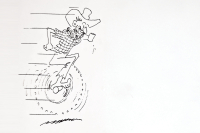Disturbing crime novel covers some dark ground
Deer hunters call it “field dressing.” The dead deer is suspended head down from a sturdy tree limb and the hunter eviscerates the deer, leaving all internal organs on the ground. The carcass is much lighter after the organs are removed, and the hunter can transport it home easily.
However, the subjects of field dressing in The Blue Hour are young women, victims of a murder/rapist who hides behind the driver’s seat of their automobiles. After murdering them, he hangs their bodies from trees (frequently in Cleveland National Forest, Orange County, Calif.) and drains their blood.
When the first murder sites are discovered, the police are baffled by the fact that there are no bodies ... just a patch of blood-soaked soil. Usually, the victim’s purse shows up – one of those large one with handles (sometimes delivered to police headquarters) – and each one is packed with the victim’s intestines.
It is probably not surprising, in view of the grisly details given above, that T. Jefferson Parker’s The Blue Hour has acquired a reputation as this prolific crime/fiction writer’s most gruesome work. Readily acknowledged as one of America’s most gifted writers of fast-paced and tension-loaded action, Parker works are usually character-driven (L.A. Outlaws, Iron River, Triggerman’s Dance). In all fairness, although The Blue Hour contains two remarkable protagonists – Tim Hess, a semi-retired veteran cop dying of lung cancer, and Merci Rayburn, a young, short-tempered and very ambitious woman who has vowed to excel in law enforcement before she is 42 – readers are likely to find that the dark and chilling interior of the “Purse Snatcher” killer’s mind dominates this novel.
Tim Hess has been divorced three times and now finds himself alone and childless. As a consequence, he begins to perceive his involvement in the Purse Snatcher murders as an opportunity to make his life count for something. His investigation is slow and methodical; his 40-year career gives him a tenuous instinct that serves him well.
Early in the investigation, he begins to build a file of tenuous details: evidence that the victim’s car had been “jacked” with a slim jim, the frayed bark of a tree limb, a tiny fuse found in a victim’s car that had no reason to be there. Tim’s investigation contrasts radically with Merci’s aggressive impatience, yet this angry woman who pistol-whips and abuses witnesses, drives too fast and leaves a trail of offended citizens every place she goes also makes significant contributions to this search for a killer who is striking with increasing frequency. Tim and Merci are a mismatched pair, but they gradually build a working relationship that becomes deeply personal.
Related Items
Like all of T. Jefferson Parker’s novels, The Blue Hour shows evidence of meticulous research. Some of the most unpleasant passages in this novel prove to be the most fascinating. Patterson’s previous works have contained marvelous arcane facts about guns, automobiles and California history. The Blue Hour bristles with fascinating and disturbing facts about abnormal psychology.
For example, one of the most offensive characters interviewed by Tim and Marci is Matamoros Colesceau, a Rumanian who is a convicted rapist and has been paroled provided that he allows himself to be “chemically castrated.” Colesceau is injected and interviewed each week, and as time passes, Colesceau loses his hair, his genitals shrink and his breasts enlarge. Due to the fact that the doctors treating him feel that he still represents a possible threat to others, his residence is revealed by the local media. The message is: “You need to know that you have a convicted rapist living near you.” Colesceau loses his job and is facing eviction. In addition, his neighbors have organized a 24-hour-a-day surveillance and protest outside his apartment.
Although Colesceau’s crimes were against elderly women and despite the fact that he is incapable of sexual performance, the public outcry orchestrated by the media brands him as dangerous. Tim and Merci must maintain a watch on Colesceau despite the tact that their search for the Purse Snatcher Killer requires interviews with possible witnesses and an exhaustive search for a silver van, an embalming machine and a man in a cowboy hat named Bill. Indeed, this frantic search becomes increasingly surreal as Tim and Merci come close to the final revelation.
Several years ago, I read another novel (English) that dealt with the same subject as The Blue Hour. In this instance, the criminal, a convicted pedophile, was living in a London suburb with his father when his cover was blown by the local media. Based on an actual event, the author described how the pedophile’s life was affected. The protests became more and more violent, and eventually it became obvious that some of the protesters were intent on mayhem and murder. Attacks were made on the pedophile’s home and some people attempted to burn his apartment.
Although The Blue Hour ended before civic violence broke out, I was left wondering about those happy campers — those folks who were camped on Colesceau’s lawn, sharing punch and cookies, passing out religious tracts and waiting for “the beast” to emerge. It may be that some insight into the morality of this murky affair is offered by the title of this novel. According to Wikipedia, “the blue hour” comes twice each day. It is that period in the morning and the evening when it is neither night or day. It is a time when it is difficult to clearly discern objects and the world seems nebulous and dim.
So, after all is over and done, the readers of The Blue Hour may not be left with just warm feeling for Tim and Merci (they certainly deserve to be viewed that way!), but also the image that may linger is “the despicable monster” trapped in his home and an angry mob at his door ... like an image from an old Frankenstein film. There is also an irony in the fact that both Tim and Colesceau are being subjected to a chemical treatment that makes their life unpleasant. As poor Tim deals with chemotherapy and Colesceau copes with Depo-Provera, both lose their hair, their appetite and much of life’s joy.
In the end, both of these men die. Colesceau’s going will cause the world to breathe easier. Tim will be remembered because during his career, he saved three lives ... four if you count Merci ... and five if you count the baby.
The Blue Hour, by T. Jefferson Parker. Hyperion, 2000. 464 pages









